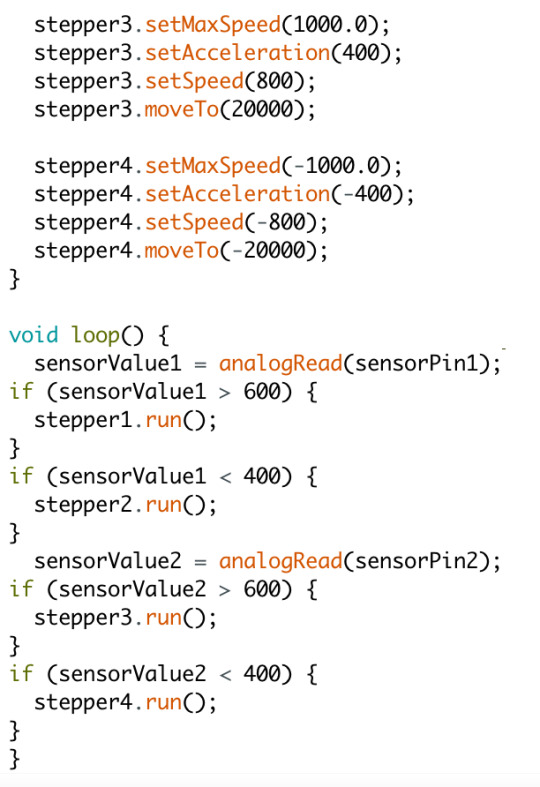Don't wanna be here? Send us removal request.
Text
Final Documentation
When the class was given the assignment for the final, some of the first pieces that came to mind were Tristan Perich’s Machine Drawings. Exemplifying the simplest and purest form of algorithmic machine art, the simple clean beauty of the piece’s movement attracted me, and inspired much of the basic mechanical concepts in my piece. The first thing that came together in my mind was using dual suspended motors from the top corners of whatever I chose for a canvas. For this task, I chose a small uni-polar 32-step 5v stepper motor, because of its simplicity and availability. Once I had my motors, and had familiarized myself with the libraries necessary for motor control, I needed to decide on an input. I briefly entertained using tilt sensors, or sonar, but then I remembered my processing project using the potentiometer hand control, and thought that not only would the potentiometer provide reliable control, but also the hand serves as a sort of signifier for rotational function. Next I began conceptualizing a canvas. Originally I wanted to use a vertically hanging writing utensil, much like the Perich piece, but soon realized that not only was it difficult to get a vertically hanging utensil to write anything, but anything that it did draw would be compelling. Eventually I came to the idea of a wet sponge through colored pigment, which would have to be on a tilted canvas. I tried a number of pigments, including the powder they use for Holi, but the one that worked the best was powdered soft-pastels. I then began fabricating the canvas, a propped up piece of flat wood, with the motors mounted on top and a space for the Arduino in the back. Next came the fabrication of the control apparatus, which involved the two rotational hand controls on either side of a wooden box, attached to a board that could rest on the ground or could be held between the legs. The final piece was semi-functional, with both controls giving reliable readings, and both motors reacting, with various degrees of responsiveness. One of the motors, inexplicably, was much weaker and slower than the other, although I replaced the wiring, motor shield, and motor itself. Additionally, the sponge had to be moved back to the bottom of the canvas after each line was drawn, as the friction between the powder coated wood and the wet sponge was enough to overcome gravity, and the sponge stuck. Despite these functional flaws, I would call the project successful. I managed to integrate sensor input with a designed apparatus to affect change on a surface that was both visually interesting, and physically interesting to interact with. Bellow, I have my final code, and photos of the machine after my post-crit trials.







0 notes
Text
Final Update
The final frame is complete, with both motors attached and string tied on. The control apparatus was complete, with the hand controls on either side, but tonight when adding the finishing touches, the solder job on the inside of the control apparatus attaching the potentiometers to the wires came loose, and the only way to fix it was to tear the whole thing apart, wood glue and all. I had to reprint pieces, and re-solder everything. Then, once that was done, it turned out that one of the motors had stopped working. I know it’s the motor, because I double checked all the controls on the other motor, and its all working. I have a backup motor, but everything is screwed in place. Not sure why I’m writing this, other than as some sort of explanation if I can't manage to fix it all in time, but the DDS closed, and tomorrow I have to unscrew the old motor, replace and rewire it, and then troubleshoot the sponge and pigment, which I haven’t been able to do since everything broke.
0 notes
Text
Update for Final
Thus far, I have successfully gotten rotational control of my stepper motor based on inputs from my potentiometer. I have begun fabrication of my apparatus, but haven’t yet been able to control two motors simultaneously because of mechanical setbacks with my motor shields. I have written my code (below), which should be able to control both motors, with only one speed. I would like to add the feature of using a higher speed at more extreme potentiometer value. I am a little worried how stable the drawing utensil will be while suspended, but I am confident I will be able to get the degree of movement control I am anticipating.


0 notes
Text
Final Proposal
For my final Drawing Machine project, I propose to build an arduino-powered slingshot. The user would stand in front of a canvas, holding the controller consisting of a series of colored buttons. Pressing one of the buttons would result in a paint balloon of the same color being fired at the user. The final product would be a silhouette in splatter paint, produced by the user’s body blocking the paint. The slingshots will probably have to be manually reloaded, and will fire using a release mechanism similar to a crossbow, using a simple notched cam, with a rotating trigger, probably attached to a mini-servo. This idea is approaching the concept of “effecting change on a surface over time” from a literal, and less digitally generated angle. Building this final project will take much more intensive physical fabrication, and probably less coding than a purely generative piece that uses a pre-written algorithm or data set to create an image.

0 notes
Text
Short Project 5b2
https://youtu.be/rR3PUjc8j-M
0 notes
Text
ShortProject-05b-01 Part 2

0 notes
Text
ShortProject-05a
https://youtu.be/Fa7vFpkf56A
0 notes
Text
ShortProject-04-02
The three pieces I chose were Jer Thorp’s “Just Landed,” Aaron Koblin’s “Sheep Market,” and solaas “Dreamlines.” Each of these three pieces’ approaches interactivity and processing in a vastly different way. The first, titled “Just Landed,” is a data visualization of air travel. The program scans public twitter feeds for the phrase “just landed,” and then determines the start and end locations of the person who posted. This information is translated into individual flight trajectories on a global map. The resulting visualization is a real-time international flight tracker, showing the movement of people all over the world. The second piece, called “Sheep Market,” is a collection of drawings of sheep, done by workers on Amazon’s Mechanical Turk. Each worker was paid $0.02 to “draw a sheep facing to the left.” The result was a gallery of 10,000 sheep drawings, all of which are for sale on TheSheepMarket.com. The massive mural that the Sheep Market creates illustrates themes of collaborative emergence, and large scale interactivity. Finally, my favorite of the three, was “Dreamlines.” This piece is a generative drawing machine, that will create unique “dreams” depending on what input the user provides. By entering text into the program, it scans the web for images related to the words used. These images are not displayed, but are instead used as the “virtual terrain” for a collection of 1500 particles. The direction and speed of each particle is determined by the color value of the photo pixel it rests on, and the result is a beautiful, dreamlike image.
Just Landed

http://blog.blprnt.com/blog/blprnt/just-landed-processing-twitter-metacarta-hidden-data
Sheep Market

http://www.aaronkoblin.com/work/thesheepmarket/
Dreamlines

“Deep Sea”

“Stillness”
http://www.solaas.com.ar/dreamlines/p5/
0 notes
Text
ShortProject-04-01
https://youtu.be/TO8DgVVaXWs
0 notes
Text
ShortProject-02-01
https://youtu.be/MFYEewkyMMo
0 notes
Text
ShortProject-01-02
https://youtu.be/6seYb2ewBwU
0 notes
Text
Responses-01-01
The first piece I chose was Alan Rath’s C-Clamp, which consists of a grimacing human face on a screen, held firmly in an industrial C-clamp. Many of Rath’s works are composed of a combination of human features and mechanical components, combined in such a way to make the familiar forms feel macabre and foreign. Meant to be darkly comedic, this piece is unsettling in mild and unimposing way, a gentle reminder to remember the separations between human and machine. The second piece I chose was Panamarenko’s Voyage to the Stars, a 1/300 scale model of a spaceship, designed by Panamarenko. Many of Panamarenko’s assemblages were heavily related to the theme of flight, often tied more to the realm of imagination and dreams than to anything resembling physics or the science of flight. This particular piece, like many of his others, is entirely nonfunctional, forcing the audience to conceptualize it without the aid of utility to define its purpose. This lack of function is the common thread between the two pieces that I thought was compelling. Both pieces are defined exclusively by their physical presence, and the messages imbued in them by their makers. They are objects that exist to communicate something, and do not exist to serve any well-defined role. Anthony Dunne described the effect these objects have as beginning to “blur the boundaries between words and things.” (p. 53) I understood this to mean that as an object is reduced to an inert symbol, it is brought towards the realm of abstract representational thought where words reside, and away from the world of task-oriented functionality.

C-clamp

Voyage to the stars
0 notes
Text
Assignment-00-02
Of all the tenants listed in “The Critical Engineering Manifesto,” I found the fifth tenant to be the most interesting. It seems intuitive to assume that we are shaped and altered by the influence of the engineered objects inhabiting our lives, but the plainly stated fact that we are directly programmed by the very technology we ourselves program is both illuminating and unsettling. Paired with the claim that this programming is directly proportional to user dependency, this tenant best reveals the two-way relationship between creator and created object. Too often the user experience is conceptualized as being wholly separate from and unaffected by the intentionality behind the form and function of a used object. To give an example, the relationship between a musician and their electric guitar is often a deeply personal one, and one that often discounts the targeted engineering of their instrument. Every choice in shape, material, electronics, and even color made by the engineer influences not just the user experience, but the way the musician plays and perceives their music.
Tenant 5: The Critical Engineer recognises that each work of engineering engineers its user, proportional to that user's dependency upon it.
0 notes
Text
Assignment-00-01

This project, created by Swiss artist Zimoun, is a permanent instillation piece in Dottikon, Switzerland, consisting of 329 dc-motors and cotton balls attached to the interior of a massive toluene tank. The piece is a sound sculpture, or as his work is sometimes classified, a piece of “sound architecture.” The motors all run simultaneously, causing the balls to bounce against the inner wall of the tank, creating a vast, changing soundscape. The effect created when many basic actions are assembled together emphasizes the emergent nature of chaos, and how easily simple systems can be layered to create complexity. Zimoun has nearly endless potential for related future projects, because of how drastically slight alterations in placement, material, and space alter the final outcome, without deviating from the original premise.
http://www.zimoun.net/2013-329.html
0 notes


































